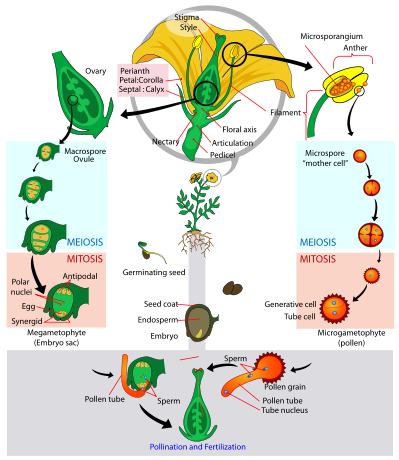Making Christmas More Fun!
Reproduction
Because
Phoradendron leucarpum is part of the
phylum Magnoliophyta (flowering plants)
and the class Magnoliopsida (Dicots), it
reproduces similarly to many flowering
plants in terms of basic sexual
reproduction. (To learn more about
Classification, click
here!) As shown in the diagram
to the
 left,
(which is of typical angiosperm
reproduction) Mistletoe exhibits
alternation of generations, including
hapliod and diploid stages of meiosis
and mitosis. When a fruiting body
is formed, the new seed (usually one per
berry) must be transported to a new
location for it to grow. This is a
job for the many animal species which
eats the berries, or unsuspecting bird
who pops the berry. To learn more
about Interactions, click
here!)
When the seed is finally carried to a
new tree or branch, it begins to form
the haustorium which connects it to the
tree and provides it with nutrients.
Until the haustorium is well established
within the host plant though, Mistletoe can
rely upon photosynthesis to provide it
with sugars, just like any other plant.
When the plant is well established it
can produce fruiting bodies, including
the white berries which give it its
famous appearance.
left,
(which is of typical angiosperm
reproduction) Mistletoe exhibits
alternation of generations, including
hapliod and diploid stages of meiosis
and mitosis. When a fruiting body
is formed, the new seed (usually one per
berry) must be transported to a new
location for it to grow. This is a
job for the many animal species which
eats the berries, or unsuspecting bird
who pops the berry. To learn more
about Interactions, click
here!)
When the seed is finally carried to a
new tree or branch, it begins to form
the haustorium which connects it to the
tree and provides it with nutrients.
Until the haustorium is well established
within the host plant though, Mistletoe can
rely upon photosynthesis to provide it
with sugars, just like any other plant.
When the plant is well established it
can produce fruiting bodies, including
the white berries which give it its
famous appearance.
To learn more about the history
of this plant, click here!
Copyright © 2007, Design by: Sunlight webdesign